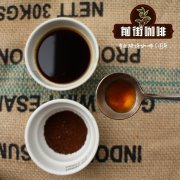Introduction to the flavor and taste of coffee variety treatment in Honduras-Irving Manor

Professional coffee knowledge exchange more coffee bean information please follow the coffee workshop (Wechat official account cafe_style)
Coffee farm, as its name implies, is the place where coffee is grown. Every country that grows coffee has large and small coffee estates, planting different varieties of coffee, the quality, taste, flavor, price and other aspects will be different.
Coffee is becoming more and more popular, and coffee-producing countries are getting more and more attention! Of course, some of the big producing countries that we are familiar with, and some small coffee countries that we do not often hear about, will take you into the coffee producing countries today!
Honduras is located in a high-altitude volcano. In recent years, improved planting and treatment have made the country one of the highest production of coffee beans in Central America, even surpassing that of Guatemala. Honduras coffee has a supple low acidity and high fruit aroma, cocoa, roasted drupe, good sweetness, drink to balance smooth.
Although Honduras does not produce much coffee, has few varieties, and even does not rank in the coffee industry, Honduras has the advantages of natural environment, such as soil quality, altitude, and climatic conditions. Neighboring Guatemala, El Salvador and Nicaragua also have advanced coffee production. Honduras lacks infrastructure and is not well-known in the consumer market.
Hongguo is better known for commercial beans than high-quality beans. No matter how good the quality is, there is no way to sell them at a good price. Many beans from Koban and Santa Barbara are mixed with fish eyes as Guardia beans. Moreover, they are sold at the price of Guardia beans, and for a long time they are not aware of their own potential for the cultivation of high-quality coffee beans. The main problem is that coffee cherries are only slightly processed. It is sold to the processing plant when it is still wet, which often causes coffee cherries to become moldy and damaged before they are officially dried until the moisture content is only 12%. Such cherries become defective beans after drying.
Since there is no relative price return for good quality, coffee farmers, processors and exporters have no incentive or incentive to increase costs to develop the potential for coffee cultivation, so that the fate of coffee beans in Honduras has become recognized as a mild mixed bean. rather than beans from a single origin or unique farm, this is a vicious circle.
[Honduras] bordering Guatemala, El Salvador and Nicaragua, it lies between the Pacific Ocean and the Caribbean Sea and has a coastline. There are two kinds of very good quality coffee produced in Honduras, one is "Highland Coffee" grown at an altitude of 1000 to 1500 meters, and the other is the "selected Highland Coffee", which represents the highest level in Honduras, growing at an altitude of 1500 to 2000 meters. Most of it is exported to the United States and Germany.
Coffee producing areas: Santa Barbara, Perry, Koban, Buzz, Gongmayagua and Olanqiu in Irving Manor.
Coffee flavor: full-bodied and deep, with complex acidity and vitality.
Coffee grade: above SHG1200 meters, above HG1000 meters.
So a coffee bean is hard to come by, and coffee is the most important economic lifeline for some countries.
Important Notice :
前街咖啡 FrontStreet Coffee has moved to new addredd:
FrontStreet Coffee Address: 315,Donghua East Road,GuangZhou
Tel:020 38364473
- Prev

Nicaraguan Coffee Manor-- introduction to the flavor and taste of coffee varieties in St. George's Manor
For more information on coffee beans, please follow the coffee workshop (Wechat official account cafe_style). Nicaraguan coffee is mainly grown in the central and northern parts of Nicaragua, covered with volcanic ash and shaded by olive trees, resulting in high-quality Nicaraguan coffee, especially the Maragogipe, a huge coffee bean produced in Madagelba.
- Next

The difference between espresso and Blue Mountain Coffee which tastes better, Blue Mountain one or Italian coffee beans?
Professional coffee knowledge exchange more coffee bean information Please follow the coffee workshop (Wechat official account cafe_style) before comparing the difference between Italian extra strong and Blue Mountain, let's share with you how to know a cup of (black) coffee: 1 Aroma coffee beans from different places, different treatments, different treatments all have their own unique aroma. Tasting a cup of coffee
Related
- Does Rose Summer choose Blue, Green or Red? Detailed explanation of Rose Summer Coffee plots and Classification in Panamanian Jade Manor
- What is the difference between the origin, producing area, processing plant, cooperative and manor of coffee beans?
- How fine does the espresso powder fit? how to grind the espresso?
- Sca coffee roasting degree color card coffee roasting degree 8 roasting color values what do you mean?
- The practice of lattes: how to make lattes at home
- Introduction to Indonesian Fine Coffee beans-- Java Coffee producing area of Indonesian Arabica Coffee
- How much will the flavor of light and medium roasted rose summer be expressed? What baking level is rose summer suitable for?
- Introduction to the characteristics of washing, sun-drying or wet-planing coffee commonly used in Mantenin, Indonesia
- Price characteristics of Arabica Coffee Bean Starbucks introduction to Manning Coffee Bean Taste producing area Variety Manor
- What is the authentic Yega flavor? What are the flavor characteristics of the really excellent Yejasuffi coffee beans?

